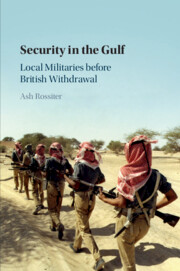Book contents
- Security in the Gulf
- Security in the Gulf
- Copyright page
- Contents
- Preface
- Abbreviations
- Introduction
- 1 Patterns of Protection in the Gulf
- 2 British India and Local Security Arrangements
- 3 Local Militaries and Intensified British Interests
- 4 Intervention or Local Means of Coercion?
- 5 Local Forces and Britain’s Silver Age in the Gulf
- 6 Securing the Gulf after Britain’s Withdrawal
- Conclusion
- References
- Index
4 - Intervention or Local Means of Coercion?
Published online by Cambridge University Press: 15 June 2020
- Security in the Gulf
- Security in the Gulf
- Copyright page
- Contents
- Preface
- Abbreviations
- Introduction
- 1 Patterns of Protection in the Gulf
- 2 British India and Local Security Arrangements
- 3 Local Militaries and Intensified British Interests
- 4 Intervention or Local Means of Coercion?
- 5 Local Forces and Britain’s Silver Age in the Gulf
- 6 Securing the Gulf after Britain’s Withdrawal
- Conclusion
- References
- Index
Summary
By the end of the 1950s, the question of whether indigenous forces would enable Britain to reduce its cost of protecting the region remained unanswered. At times during the tumultuous mid-1950s, British defence planners and foreign office mandarins had such little faith in the ability of local forces to keep order in the midst of social and labour unrest that they believed no other avenue was open but to rely on the British Army. Even when local forces were judged to have performed well operationally, British observers were quick to point out that they still depended on British military support, usually in the shape of RAF transport and combat aircraft and Royal Navy frigates. Moreover, it was British assistance to these forces that was held up as the most important factor in their efficacy. In this way, local forces should be thought of as complementing Britain’s military architecture rather than replacing it. Whilst instability around the time of the Suez Crisis reduced British confidence in the ability of local forces to maintain order, Britain still wanted to reduce the size of its garrison stationed in the Gulf.
Information
- Type
- Chapter
- Information
- Security in the GulfLocal Militaries before British Withdrawal, pp. 102 - 148Publisher: Cambridge University PressPrint publication year: 2020
